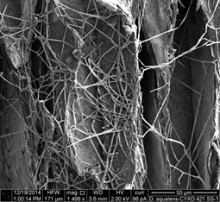
Carbon is money. Nowhere is this more evident than in our dependence on hydrocarbons in the form of fossil fuels. Scientists and engineers have been grappling with the question of what alternate carbon sources are available when our demand for fossil fuels eventually outstrips our supply. This challenge has provided motivation to use expertise and equipment available at EMSL, the Environmental Molecular Sciences Laboratory, to create technologies that use sustainable carbon sources from biomass.
The carbon in the most abundant forms of biomass, wood and non-woody plants, is made up of three major components: cellulose and hemicellulose, which are sugar polymers; and lignin, an aromatic polymer. Although the sugars in cellulose and hemicellulose can be fermented to biofuels, researchers haven’t found an effective way to use lignin, which is about a third of the biomass, to generate energy or biochemicals.
“There’s an urgency to increasing the economic viability of biofuels and bioproducts,” said Scott Baker, the Science Theme lead for Biosystem Dynamics and Design at EMSL. “Understanding how lignin is deconstructed and utilized by microbes is an important science challenge. Through the EMSL User Program projects working with scientists in this area, we are working to accelerate and amplify the impact of lignin deconstruction research.”
Dissolving Wood with Liquid Salt
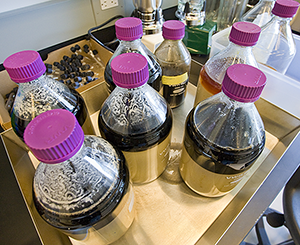
Difficulties degrading lignin have hampered exploitation of the full potential of biomass currently used in biotechnology for the production of biofuels and renewable chemicals. The challenge of overcoming these difficulties undergirds much of the lignin deconstruction research at EMSL. For the most part, early technologies to deconstruct wood (such as those in pulp and paper mills) have disregarded lignin for its potential as a source of renewable chemicals and typically burn it for heat and power production. This mentality of lignin as waste stream has been carried over into newer biotechnological processes for producing biofuels.
“The main goal has basically been to get rid of lignin so that cellulose can be easily digested using enzymes,” said Seema Singh, director of Biomass Petreatment at the Department of Energy-funded Joint BioEnergy Institute, or JBEI. Singh disagrees with this idea; however, “If you want to be self-reliant for energy security and not dependent on foreign oil you cannot just make fuel, you have to replace the whole barrel of oil.”
According to Singh, using biomass to replace all of the uses of a barrel of oil requires the production of industrially relevant chemicals with aromatics. This is where lignin is important. “Lignin is the only source of renewable aromatics,” she added.
Creating biomass-based equivalents to what can be found in a barrel of oil is the focus of the project Singh is working on with EMSL, in partnership with JBEI and the Sandia National Laboratories. She and her team have two major interdependent goals. The first is to find ionic liquids effective for dissolving wood-bound lignin into its component aromatic molecules. The second goal is to determine how these aromatic molecules can be combined to create high-value chemicals.
To achieve the first goal, Singh plans to use EMSL’s mass spectrometry, nuclear magnetic resonance and electron paramagnetic resonance spectrometer capabilities to determine the composition and structure of lignin’s component molecules. This will involve dissolving lignin and lignin-like chemicals in ionic liquids.
Ionic liquids are salts that are liquid at room temperature. Like table salt, they are made up of a positively charged ion and a negatively charged ion (cation and anion respectively). In contrast to salts that are solid at room temperature, in ionic liquids the cation is large in comparison to the anion, preventing crystallization. Using ionic liquids as solvents allows scientists to pick and choose the ions they use to make the salt. “We call them designer solvents,” said Singh. “So I can have an ionic liquid that only solubilizes lignin, or cellulose, or both.” Often with little added heat or pressure to speed up the reaction.
Singh’s second project goal will use computing resources from both EMSL and JBEI to model and understand the reaction mechanisms required to build industry-relevant chemicals. She is especially interested in creating platform chemicals, which are chemicals that can be used as building blocks for high-value products.
Mapping Fungal Pathways
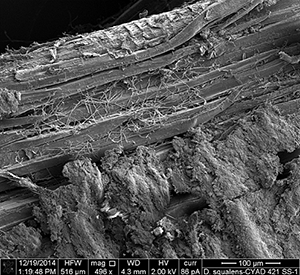
Blake Simmons, chief science and technology officer and vice president of the Deconstruction Division at JBEI, is one of EMSL’s collaborators and an EMSL Wiley Fellow. The object of Simmons’ research, which is funded by JBEI and Sandia National Laboratories, is to create a metabolic map of the pathways used by microorganisms to degrade lignin.
“We have a [mapping] device that is really good at understanding central metabolism and sugar metabolism in organisms, but there’s still very little known at that same level of detail, nuance and robustness around lignin conversion,” said Simmons.
To achieve a deeper understanding of lignin metabolism, four organisms will be grown on aromatic molecules similar to lignin degradation products. Simmons plans to then elucidate the active pathways in the organisms using EMSL’s new 21 Tesla mass spectrometer for metabolites, an Orbitrap mass spectrometer for proteomics and the SOLiD sequencing platform for transcriptomics.
These four organisms are only the first of many that will ultimately make up a much larger database available to the scientific community. According to Simmons, “We want to build that understanding of the metabolic networks in organisms that can use lignin as a carbon source, and then develop a predictive biology tool about understanding its metabolism.”
Simmons’ goals echo and complement those of Singh. “One third of your biomass is lignin, and right now there is no compelling use for that, like there is for sugars,” said Simmons. But because lignin makes up such a large fraction of total woody biomass he’s convinced there are better uses than waste. “I don’t think many industries would throw away or burn a third of [their] input feedstock just because [they] don’t know what to do with it,” Simmons added.
A System-Level Understanding of Fungus
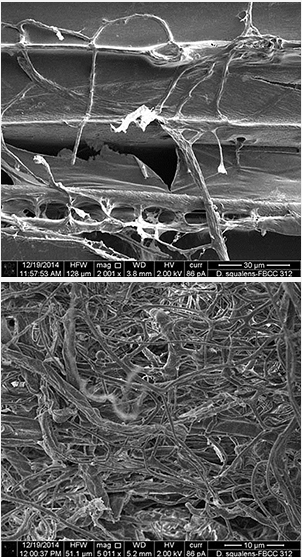
Ronald de Vries, group leader of fungal physiology at the CBS-KNAW Fungal Biodiversity Center in The Netherlands, asked himself one particular question as he was writing his EMSL user proposal – “What would be something we would do with EMSL that we would never be able to do without EMSL?”
This question was important to de Vries because working with EMSL provides him with unprecedented access to expertise and equipment.
“The combination of tools they have at EMSL is not likely to be found anywhere else, certainly not in Europe,” he said.
De Vries’ user proposal will put EMSL through its paces with an exhaustive analysis of different strains of white rot fungi, also known as basidiomycetes. De Vries, and his collaborators from the University of Helsinki, Kristiina Hildén and Miia Mäkelä, intend to use a swath of EMSL capabilities to gain a system-level understanding of the colonization and degradation of woody biomass by white rot fungi both at the strain level and in its two different sexual phases. The research plan includes transcriptomics, proteomics, metabolomics and microscopy. “We had something like 500 samples in total for all the different analyses,” said de Vries. Generating the samples took seven months of full-time work from one of his Ph.D. students.
He and his collaborators are hoping to incorporate the multi-omics data into a model. They also want microscopy visualization of both the asexual parent form (the monokaryon) as well as the sexual form, which is seen in nature as a mushroom (the dikaryon). Little is known about the lignin-degrading properties of each sexual form, or how each colonizes wood. “We want to visualize how the fungus enters the wood, and does it grow over the surface or does it penetrate?” said de Vries.
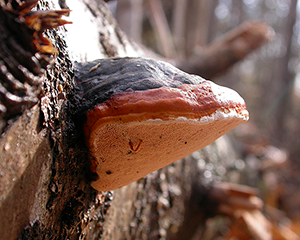
Reaching Around the Corner
Visualization of fungal activity is also a key component of the research of Jonathan Schilling, associate professor at the University of Minnesota. A proposal he submitted in response to an EMSL special call is focused on looking into the degradation action of brown rot fungi.
The fungus itself is unique because it uses a kind of pretreatment on the wood. “The initial step [in degradation] is believed to not involve enzymes, but instead a bunch of oxidative chemistry that reduces strength in the wood,” said Schilling.
According to Schilling, brown rot fungi circumvent the lignin barrier, “They’re trying to stick their hand around the corner and grab the sugars out from the wood,” he said. This strategy has led to them being overlooked in terms of biotechnology, and most of the early research on these organisms focused on how they caused structural damage to wood buildings. “I think most people would assume that a system that degrades lignin – which is very unique – is the thing to focus on,” said Schilling, but from his perspective, brown rot fungi, with its combined pretreatment and enzymatic action, allows for a system-level understanding of the degradation process.
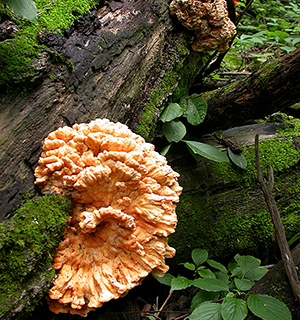
In recent years, research and government institutions have begun to recognize potential applications for these fungi that have historically been regarded as a nuisance. These changes have been reflected in Schilling’s funding sources; the Department of Energy provided funding for the work he’s doing with EMSL, including an early career award for studying these unique mechanisms.
Schilling’s prior research examined the activity of brown rot fungus at the micrometer scale, but that level of resolution didn’t provide the detail necessary to see the unique set of reactions taking place at the junction between the fungus and the wood.
Now Schilling and his collaborators can image fungal reactions down to the sub-micrometer with EMSL’s helium ion microscope in the Quiet Wing. They also will be able to see where certain functions are expressed in the fungal tissue by binding fluorescent molecules to the genes and visualizing their spatial distribution using a structured illumination microscope.
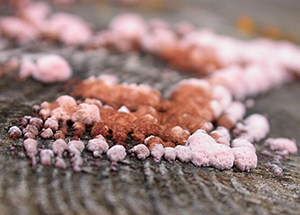
“The work at EMSL is really valuable for us because the tools are spatial and high-resolution, and there are excellent scientists there to help us harness [the tools’] potential. We are mapping things that are happening in space and getting a feel for not just one enzyme or one gene but for multiple moving parts,” said Schilling, “In this era of big data, these spatially resolved approaches are key.”
The findings from the woody biomass deconstruction projects taking place at EMSL, when combined together, will culminate in a more comprehensive understanding of lignin degradation and the assembly of lignin-based chemicals. This added knowledge brings a renewable and sustainable energy future a little closer.
For Baker, achieving this future will ultimately depend on the cost of carbon. Which means not throwing away, or burning, that most valuable of resources.
“Carbon is key,” said Baker, “we don’t want to leave any carbon on the table.”
Amy Boaro is a post-doctoral researcher at Pacific Northwest National Laboratory.
Source
Environmental Molecular Sciences Laboratory, press release, 2015-09-02.
Supplier
CBS-KNAW Fungal Biodiversity Centre
Environmental Molecular Sciences Laboratory (EMSL)
Joint BioEnergy Institute (JBEI)
Pacific Northwest National Laboratory PNNL
Sandia National Laboratories (USA)
University of Helsinki
University of Minnesota
US Department of Energy (DoE)
Share
Renewable Carbon News – Daily Newsletter
Subscribe to our daily email newsletter – the world's leading newsletter on renewable materials and chemicals









